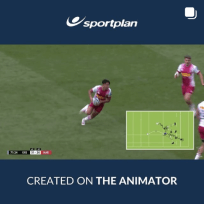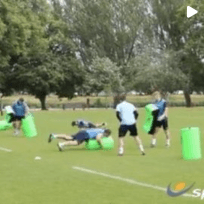Sportplan rugby has played a large role in my team's love for the game!
When a scrum is awarded following an unsuccessful end to a maul, which team throws the ball in?
During a recent U17's league game, the opposing side took two consecutive quick tap penalties. During a break in play shortly after, as the coach attending an injured player, I questioned the referee on the legality of this passage of play, as my understanding was that two consecutive quick taps, used to catch the opposition in an offside position and therefore gain terratorial advantage, was not allowed under current law. The referee responded that this law is at his discretion and when we discussed after the game, he stated there is no such aw and that it is a "gentlemens agreement". I have since reviewed the laws on penalties and there is no specific law preventing a side taking two quick tap penalties. Has anyone else come across this interpretation and how can this be managed consistantly if when watching elite games, such a move is not allowed yet can be allowed at junior level ?
The law says that a forward pass is one "thrown forward" "in the direction of the opponents' goal line" Does that mean that, if the ball is passed and the receiver catches it NEARER to the opponents goal line than from where the ball was passed that the pass was forward? (Leaving to one side any other touches of the ball that might have taken place.) Maybe an example is better. Player 1 passes the ball sideways - releasing it on the 22 metre line. Player 2 (with no other player having touched the ball), running from well behind the 22 metre line, catches the ball when it has travelled sideways but the ball is now 20 metres from the opponents goal line (2 metres further forward from the place that the ball was passed). Is that a forward pass or throw forward? And if not, why not?
switch pass in rugby union
WHAT IS THE LAW REGARDING HANDING OFF IN THE FACE IN UNDER 13S GAME
My under 18 team tried to take a quick lineout with one attacker in the lineout and 2 defenders in the lineout. When he threw the ball to another attacker who was about 10metres behind the lineout he was told by the referee that the lineout had formed and could not take a quick penalty. What is the clarification of this as I always thought you had to have at least 2 players from each team in the lineout to say that the lineout had formed?
Tackle and release. What is the best way to teach the new application of law 15.4 and 15.5 as played in the Super14. This application of the law is also applied to all levels of rugby in SA.
From a tap restart may the player who is to first receive the ball start runnning before the player taps the ball? The player receiving the ball is at all times behind the player tapping the ball.
if i throw the ball forward and catch it before it touches any opponent or the ground is that a forward pass
I will be coaching under 10 next season and need some guidance on how to interpret the rules for the maul?
Offside confusion - I have been coaching mini rugby in Scotland for just over a year and had just got used to the idea that the ball is the off side line. Now under the new SRU law variations it is the same as the adult game. Can someone assist with the follwing scenario - A defender comes forward to tackle the ball carrier. The ball carrier side steps the defender and carries on going forward. The defender turns to give chase only to find that the ball carrier has passed the ball backwards across his path in attempt to reach his team-mates. If the defender catches the ball is he off-side? Would the answer to this question change if the defender was on the right side of the ball at the time the interception was made even though he was beyond the ball carrier at the time which the pass was made?
Hi, I need help with this multiple-choice question from the world rugby laws test. When is the non-throwing scrum half offside when the ball is in a scrum?;1. When stepping ahead of the ball with either foot at the side the ball is thrown in2. When stepping ahead of the tunnel, but not the ball, at the side the ball is thrown in3. When stepping ahead of the hindmost foot at the side the ball is not thrown in4. When moving away from the scrum and not retreating 5m behind the scrum5. When moving away from the scrum and remaining ahead of the hindmost foot in the scrum
I'm coaching and reffing U11 rugby and one of my players is the definitive 'big lad'. His 'strength' is his size and his power, but last weekend he didn't seem to get reffed fairly. The opposition couldn't tackle him down, one on one and when another two joined in to make a mini maul, that didn't slow him down much either. The ref then let other people join in the (one sided) struggle to tackle him down, which seemed very unfair as A) it's outside the laws of U11 rugby,, B) it makes it nigh on impossible for him to offload, C) when he is brought to ground, he has 4-5 players all over him and he got pinged for 'holding on'. He is a recent arrival to rugby and it was our first game for a couple of months, so the situation hadn't reared his head before. We are keen that he learns all of the core skills of rugby and doesn't get used as a battering ram, but after seeing a pack of hyenas trying to pull down the big fella, something just didn't seem right to me.I'd be grateful for any thoughts and opinions.
Is sealing the ball at the tackle and ruck legal again?
can you touch the player on the ground? can you place your hands over the player onto the ground? any information on this would be really helpful.
At the breakdown is blue ball carrier gets tackled going to ground. The next blue player arrives and crouches over the ball and anchors onto the tackled player. Is this legal? It is assumed that he's not off his feet etc which is a separate offence
Hi I need help with this multiple-choice question from the world rugby laws test. How must the props bind when the front rows engage?;1. Loose head prop binds outside the tight head's right arm2. Tight head prop binds outside the loose head's left arm3. Tight head prop may bind on the loose head prop's upper arm4. Tight head prop may opt not to bind5..All props must bind on the back or side of the opposing props' bodies6.Once bound, props may exert upward or downward pressure on opponents
What is the clear definition of "rolling away"? Playing in the SCRFU we've been penalized a few times for the ball carrier (sometimes tackler) not rolling away when they are at the bottom of a pile. Even when raising our hands and not making any play for the ball. We simply can not move from the pile because our leg/head/arm is beneath other players. It seems like a misinterpretation of the rules and their intent to prevent the play from continuing.
When a scrum is awarded following an unsuccessful end to a maul, which team throws the ball in?
Simon My son's PE teacher has told him that Bridging is lieegal for the U13 to U19 group. His Club coach has been encouraging its use in games for two seasons. I can see some of the dangers but also the advantages Who is right is it banned or can it be used? Paul submitted by email

in more ways than one




Here are the 5 ways that you can kickstart your 2025 in the correct way with Sportplan and make this the best coaching year you have had!

How did the Modern Olympics originally begin and why are they so culturally significant today?

The Professionalisation of Netball is changing the game. Here is how it is helping to develop the sport.
Coaches from around the world look to Sportplan for coaching confidence.